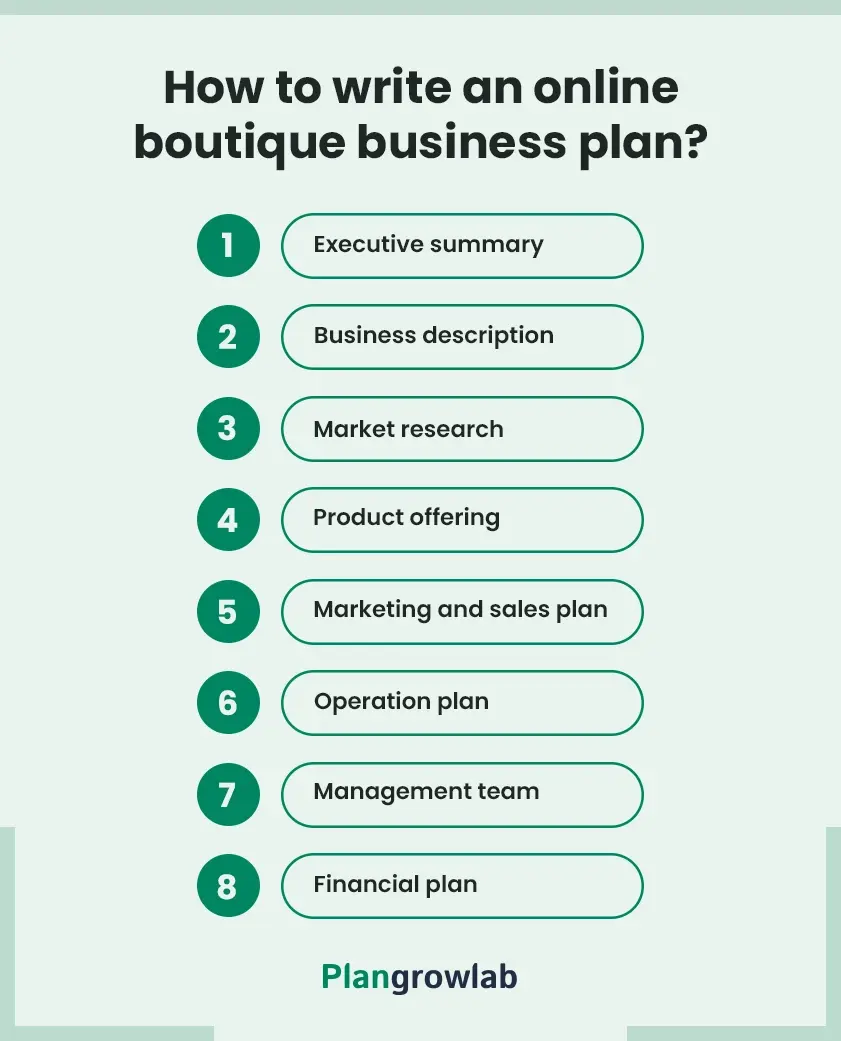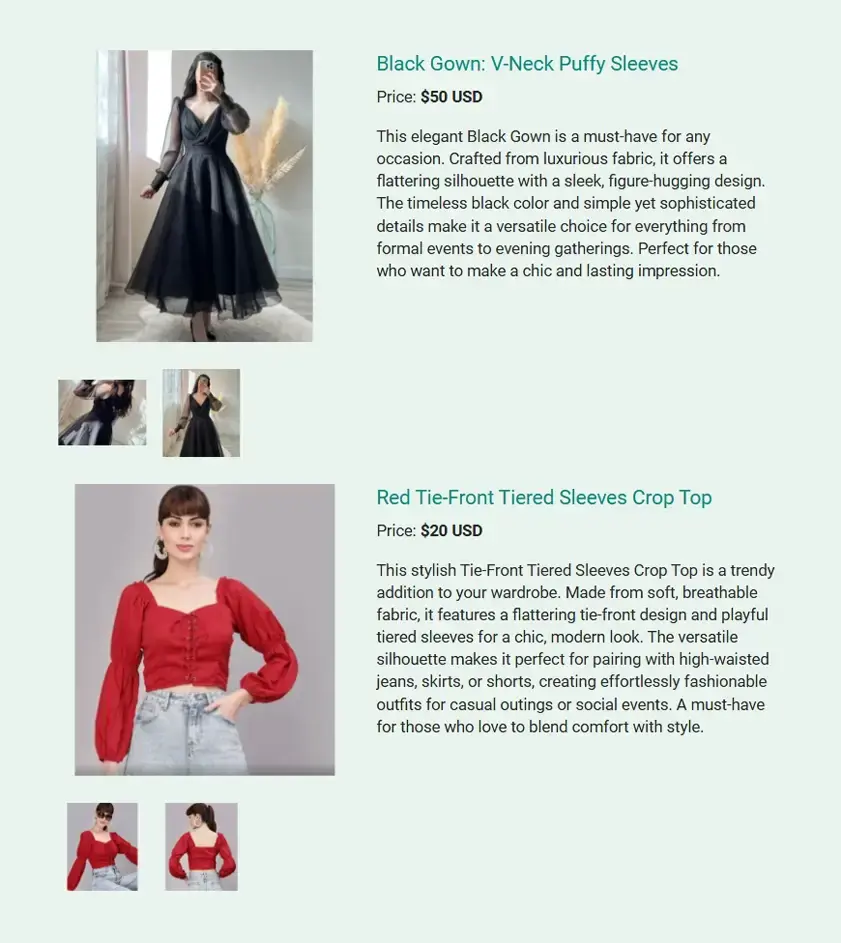Writing a comprehensive business plan might feel overwhelming, like navigating uncharted territory. Even Kelly Avery, the founder of The Pink Boutique, shared similar feelings when she was starting out.
Actually, I recently had a conversation with Kelly about her journey.
We talked about how she established a successful clothing boutique and what it takes to create a solid online boutique business plan.
From that conversation, I’ve prepared this detailed guide to help you develop your own plan that covers all the essential elements and wins investors.
Why you need a business plan for an online boutique
Starting a business without a plan is like making a road trip without clear maps. You may move forward to some extent, but you’ll probably lose your direction and make wrong turns.
So, keep a clear, actionable business plan with you as it helps you:
- Clarify your goals and steps to achieve them.
- Secure funding from investors or from lenders.
- Specify your daily operations and areas of priority.
- Stay organized and be ready to handle potential challenges.
In short, preparing an effective online boutique business plan is your key to building a thriving business!
How to write an online boutique business plan?
When writing a business plan for an online boutique, it’s important to carefully focus on several key steps and elements to bring your vision to life on paper.
Here’s how you can structure your plan effectively and set your boutique up for success:

1. Executive summary
The executive summary is one of the most crucial parts of your online boutique business plan. It’s going to give a quick and clear overview of what your business is all about and why it's unique.
Though it's the first section of your plan, it’s more convenient to write your executive summary at the last. This way, you can pick out the key points from the other sections and summarize them clearly.
Here's what to include in your plan summary:
- Your boutique’s name and the main idea behind it.
- Your target customers and what makes your boutique unique.
- The products you’ll sell.
- The market opportunity and how your business fits in.
- Your marketing and promotion strategy.
- Financial highlights
Overall, think of an executive summary as a kind of sneak peek into your clothing business. Keep it short and sweet, and engaging enough to make readers know more!
"When I first started writing the executive summary, I found it difficult to condense my entire vision into just a few lines.
However, once I laid out the key points from all the other sections, it became much easier to create a clear and concise overview.
It was critical to keep it engaging but short since it’s the first impression investors will get about my online boutiques." — Kelly Avery
2. Business description
Now, let's get into the story and purpose behind your online clothing boutique. This section helps investors or partners understand why your business exists and what makes it special.
So, try to include the following information:
- Boutique concept and key owners: What is your boutique about, and who owns it?
- Vision, and mission statement: What are your core values and future goals?
- Type of boutique: Are you focusing on trendy fashion, eco-friendly items, or luxury accessories?
- Physical location: Even though your boutique is an online store, mention where you're based.
- Legal structure: Sole proprietorship, LLC, or other?
Moreover, explain why you opened your online boutique and what inspired you. Be genuine—personal stories connect more than just facts.
Lastly, don’t forget to mention any necessary licenses or permits, like business registration or sales tax permits.
"The business overview section was really personal for me and helped me reflect on why I wanted to start this boutique.
Sharing my story and mission allowed me to connect with investors and customers on a deeper level.
Writing down my vision also helped me clearly define what my boutique stands for and what makes it a unique brand." — Kelly Avery
3. Market research
Conducting thorough market research will help you determine the success and growth of your online boutique.
It also allows you to better understand the environment in which your business will operate and identifies opportunities for differentiation.
While planning this section, consider answering a few questions, like:
- What is the size of the online fashion industry?
- What is the current status of the online boutique industry? Is it growing or declining?
- What is the future growth projection for the next 5 to 10 years?
- What are the current trends, whether it's eco-friendly clothing or minimalist styles or athleisure?
- Who are your main competitors? What are their strengths and weaknesses?
- Who are your potential customers and what do they want?
If required, you may also create a buyer persona that details the ideal customer needs, preferences, and purchasing behavior.
"Conducting market analysis was a bit tricky, especially because the online fashion market is so competitive.
However, diving into customer trends and understanding my target customer audience was one of the most important steps I took.
Creating a buyer persona helped me clearly understand the needs and preferences of my ideal customers, which ultimately shaped my business decisions." — Kelly Avery
4. Product offering
This section talks about what you’ll sell in your online clothing store.
Main categories of products you'll sell: Clothes, accessories, shoes, etc. In case you have special items such as custom-designed t-shirts, unique jewelry, or one-of-a-kind handbags, then do highlight them too!
For a better understanding, you may refer to the below example:

Also, share your pricing strategy—how much you'll charge for each item.
If you plan to have additional services, such as gift wrapping, custom orders, or personal styling advice, mention them as well.
Furthermore, emphasize your boutique's branding and style, with products that fit with the target customers and boutique theme. Focus on what you can do best and what your customers will love.
"Deciding on the products for my clothing business felt daunting at first. But once I focused on what I knew best and what I was passionate about, it made it easier.
The competitive analysis really helped me price my products appropriately, making sure I offered the best value for my target customers.
Highlighting my unique pieces, like custom accessories, gave my boutique a special touch and attracted the right customers." — Kelly Avery
5. Marketing and sales plan
Great products are only half part of the equation; it's essential to have a clear marketing plan to get the word out.
Your marketing plan is what outlines the ways you’ll promote your online boutique to reach that target audience and boost those sales.
Here are some sales and marketing strategies that you should include:
- Social media marketing channels (Instagram, Facebook, TikTok) to show off your products
- Email marketing newsletters or promotional campaigns to keep in touch with customers
- Influencer or other boutique brand partnerships to reach new audiences
- Special discounts or flash sales to encourage purchase
- Referral programs or loyalty programs to keep customers coming back to you
In short, developing a well-thought-out marketing and sales plan will showcase potential investors or partners how you intend to advertise your fashionable clothing offerings and grow a loyal customer base.
Hence, be clear and focused, and most importantly keep your ideas practical and customer-driven to make your marketing strategies more effective.
"When it came to creating a marketing strategy, I had to be realistic with my marketing budget. With limited funds for paid advertising, I chose to focus on free channels like Instagram and Facebook to reach my target audience.
Consistency with social media posts and regular email campaigns has been key to growing my customer base and building loyalty.
Finding cost-effective ways to market really helped get the word out about my clothing boutique." — Kelly Avery
6. Operation plan
In the operations plan section, outline your online boutique's day-to-day operations and processes with clarity on how you intend to run your business successfully.
For example, you may describe all your business operational intricacies, such as:
- Staffing needs: How many people do you need, and what are their roles?
- Daily tasks: What you’ll be doing every day, including managing stocks, processing orders, or handling customer inquiries?
- Inventory management: How will you manage products and order supplies?
- Shipping and packaging: How do you pack and ship orders?
By adding all the above aspects, you show potential investors or partners how you'll be managing the daily or weekly activities of your clothing business.
"Drafting the operations plan was a bit overwhelming at first because there were so many moving pieces to consider.
But once I broke it down into manageable tasks—order fulfillment, inventory management, customer service—it made everything feel more organized.
Having a clear operations schedule helped me see exactly what was needed to run the business smoothly and allowed me to stay on track." — Kelly Avery
7. Management team
This section introduces the key team members who will help run your online boutique, showing that you have a capable group in place to bring your vision to life.
As the boutique owner, start by sharing a bit about yourself—your background, role, and the responsibilities you'll handle.
Next, list your core team members, such as the marketing manager, inventory coordinator, or customer support lead. Highlight their roles, expertise, experience, and skills that will help your boutique grow and succeed.
A well-detailed management team section helps reassure potential investors or partners of your boutique’s strong potential for success.
"As an online boutique business owner, when I first started, it was just me managing everything. But as my boutique grew, I realized the importance of having a strong team.
I’ve since started outsourcing key roles, like marketing and customer service, which has freed up my time to focus on expanding my product offerings and growth.
Thus, having reliable help has been a game changer." — Kelly Avery
8. Financial plan
Your online boutique financial plan is a statement of how your business is going to make and manage the money.
This section is essential for you and potential investors to measure whether your business is financially viable or will be sustainable in the long run. It helps a lot in securing funds.
Typically, your financial plan must enclose a few critical financial projections for the first 3-5 years:
- Startup costs for your boutique
- Income statement (profit and loss statement)
- Cash flow statement
- Balance sheet
- Break-even analysis
- Funding requirements
Apart from all these financial statements, you may also include your sales projections, the operational expenses, and even do scenario analyses.
"The financial planning was the hardest part for me initially because predicting sales and expenses seemed like a huge task.
But once I laid out the startup costs and calculated my expected revenue and expenses, it started to make sense.
Doing a break-even analysis really helped me understand the point where I’d start making a profit. It was reassuring to see that my business was heading in the right direction financially." — Kelly Avery
Download now online boutique business plan template
Ready to create your online boutique business plan but need some extra help? No worries! Here, you can download a free online boutique business plan template PDF.
This template has helped many online boutique owners get started their businesses successfully. With practical examples and insights, it will also guide you in creating a solid business plan. Just download it and customize it to fit your needs.
Conclusion
Now that you’ve gone through this guide, crafting your own online boutique business plan should be much easier.
But if you wish to get professional advice to perfect your plan to impress investors, consider reaching out to the top business plan consultants.
Our team of experts will help you prepare an effective business plan as well as provide you with helpful insights and support geared specifically to your business.
So, don’t wait—start building a stronger, more compelling plan today!
Frequently Asked Questions
What key components should an online boutique business plan include?
Include the following important key components in your online boutique business plan:
- Executive summary
- Business description
- Market research
- Product offering
- Marketing and sales plan
- Operation plan
- Management team
- Financial plan
How much does it cost to write an online boutique business plan?
The cost varies. If you do it yourself, it's free except for your time. But if you hire a business plan writer or consultant, the cost will vary from $500 to $3,000 or even more depending on the type of business plan you need. And if your budget is pretty tight, you can simply use an online boutique business plan template or example for creating your plan.
How can I ensure my online boutique business plan stands out?
Make your plan stand out by being clear, focused, and professional. Include detailed information about the target market, products, marketing strategies, and financial plans. Show what makes your boutique unique and how it will succeed in a competitive market.
How can I use my online boutique business plan to secure funding?
A well-structured online boutique business plan shows potential investors or lenders that you are serious about your business and have a roadmap to success.
It highlights your boutique's unique products, target audience, financial goals, and expected profitability. This approach helps establish trust with potential backers, making it more likely that you'll secure the funding needed to expand your business.
What are some common mistakes to avoid in an online boutique business plan?
While writing an online boutique business plan, you should avoid these common mistakes:
- Not clearly defining your target market
- Overestimating sales projections
- Neglecting a strong marketing strategy
- Leaving out key financial details
- Being too vague in your goals or product offerings
How often should I update my online boutique business plan?
It's very crucial to update your online boutique business plan regularly, although at least once a year, or more often when there are major shifts in the business or market conditions.

